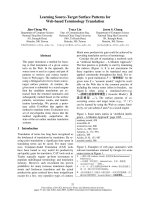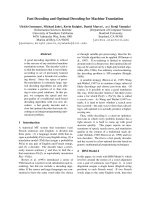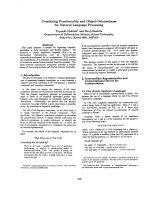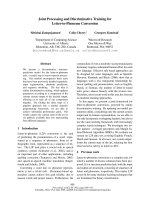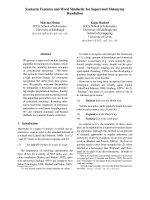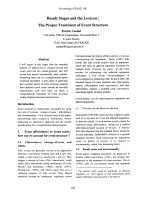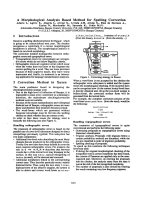báo cáo khoa học: "Physician attitudes and treatment patterns for pancreatic cancer" docx
Bạn đang xem bản rút gọn của tài liệu. Xem và tải ngay bản đầy đủ của tài liệu tại đây (247.63 KB, 7 trang )
RESEARCH Open Access
Physician attitudes and treatment patterns for
pancreatic cancer
Jarret Woodmass
1*
, Jeremy Lipschitz
2
, Andrew McKay
2,3,4
Abstract
Background: Surgery appears to be an underutilized treatment option for pancreatic cancer. Nihilistic physician
attitudes may be partly responsible. The study objectives were to analyze physician attitudes towards this disease
and determine treatment patterns and outcomes inclu ding rates of surgical referral.
Methods: A survey was administered to 420 physicians in Manitoba to document general knowledge and
attitudes. Population based administrative data was accessed for all patients diagnosed with pancreatic cancer
between 2004 and 2006 to examine treatment patterns and outcomes.
Results: 181 physicians responded to the survey. Most (73%) believed that surgical resection was worthwhile. Of
the 413 Manitobans diagnosed with pancreatic cancer, only 11% underwent an attempt at surgical resection. There
were 124 patients with stage I or II disease (i.e. potentially resectable), 85 of these patients received no treatment
and 39% were not referred to a surgeon. These patients were older than tho se referred, but did not have more
comorbidities.
Conclusion: Most physicians were insightfully aware of both the sur vival benefit and potential risks of surgical
resection. However, some did overestimate the surgical mortality and underestimate the associated survival benefit.
Although advanced age may justly account for some of the patients not receiving a referral, it is reasonable to
assume that nihilistic physician attitudes is contributing to the apparent underutilization of surgery for pancreat ic
cancer. Efforts should be made to ensure that eligible patients are at least offered surgery as a potential treatment
option.
Background
Pancreatic cancer is an aggressive malignancy which
portends a very po or prognosis. In 2009 it i s estimated
that there will be 3900 n ew cases of pancreatic cancer
in Canada, with an equal number of deaths from the
disease. This makes it the 5
th
leading cause of cancer-
related death [1]. Currently, the treatment offering the
best chance for disease-free long-te rm survival is surgi-
cal resection of the tumor [2]. However, it appears that
only 20-35% of the potentially resectable patients are
undergoing surgery [2-5]. One pote ntial reason for the
low rate of surgical resection may be the nihilistic view
held by many physicians towards pancreatic resection.
Throughout the 1 970’ s many authors had suggested
abandoning the use of surgical resection altogether as a
treatment for pancrea tic cancer due to an operative
mortality rate in excess of 20%[5-8] and a variable
5-year survival rate averaging approximately 7% [7].
Major pancreatic surgery is now safer than it has ever
been, and there is good evidence to suggest a s urvival
benefit [2]. High volume centers now routinely report
mortality rates between 1% and 4% [9] and five-year sur-
vival rates exceeding 15% [10-12]. Although there may
exist some controversy about the definition of “ high
volume”, a cut-of f of 11 or more pancreatectomies per
year is often u sed to define a high volume center [13].
Despite these improvements, in a large population-based
study in the United States Bilimoria et al found that
even after accounting for severe comorbidities, advanced
age and patient refusal, 38% of patients with stage I dis-
ease were not even offered surgery [3]. It cannot be
overlooked that there is still a relatively poor prognosis
for patients with pancreatic cancer even with pancrea-
tectomy, and that the surgery carries serio us morbidity
and mortality. However, such patients should at least
* Correspondence:
1
Faculty of Medicine, University of Manitoba, Winnipeg, MB, R3E 3P5, Canada
Full list of author information is available at the end of the article
Woodmass et al. World Journal of Surgical Oncology 2011, 9:21
/>WORLD JOURNAL OF
SURGICAL ONCOLOGY
© 2011 Woodmass et al; licensee BioMed Central Ltd. This is an Open Access article distribute d under the terms of the Creative
Commons Attribution License ( g/licenses/by/2.0), which permits unrestricted use, distribution, and
reproduction in any medium, provi ded the original work is properly cited.
have surgery presented as an available treatment option.
The aim of this study was to assess physician attitudes
towards pancreatic cancer in order to ide ntify any fac-
tors that may be limiting the treatment options being
made available to patients. Additionally, we assessed the
current treatment p atterns of pancreatic cancer in the
Province of Manitoba including the rate of surgical
referral, overall mortality and 3-year survival.
Methods
Survey
The questionnaire was designed based on the recom-
mendations of Polgar and Thomas [14]. A pilot was
administered to a focus group consisting of six physi-
cians with varying levels of knowledge about pancreatic
cancer to identify/correct any problems or ambiguity
within the survey.
Two hundred of the 902 Family Physicians with an
active license to practice in Manitoba were randomly
selected to receive the survey. In addition, all physician s
practicing in General Surgery, Internal Medicine, Gas-
troenterology, Radiation/Medical Oncology and Geria-
trics were administered the survey, for a total of 480
physicians.
Treatment Patterns and Outcomes
The Manitoba Cancer Registry (MCR) was used to iden-
tify all patients diagnosed with pancreatic cancer in the
Province of Manitoba b etween January 1, 2004 and
December 31, 2006. The year 2004 was chosen because
this is the first year the Cancer Registry began recording
detailed collaborative TNM staging data. The stop date
in 2006 allowed for at least a 3-year follow-up period
for each patient enabling an analysis of survival trends
associated with the different treatments provided to
pancreatic cancer patients. Only patients with adenocar-
cinoma of the pancreas were included.
The MCR is linked to several administrative databases
managed by Manitoba Health including the Medical
Claims Database, the Hospital Separations Abstracts,
and the Manitoba Health Registry. The combined infor-
mation from these databases provided regional data (eg.
incidence/prevalence/mortality), demographic data (eg.
age/sex/income), treatment information (eg. referral/sur-
gery/chemoth erapy) and comorbidities (up to 16 comor-
bid diseases). The MCR also provided detailed tumor-
specific information and TNM status as derived from
pathology, histology and cytology reports. The MCR
uses a collaborative staging system where surgical
pathology is used to determine stage when available. In
cases where surgery is not performed, the stage is
assigned according to the best available data inc luding
diagnostic imaging, cytology, histology, laboratory and
clinical results. Each patient was staged according to the
American Joint Committee on Cancer (AJCC) Staging
Manual, 6
th
ed [15]. For the purpose of analyzing the
data, patients with AJCC Stage I or II disease were
grouped as “Early Stage” and those with AJCC Stage III
orIVdiseaseweregroupedas“ Late Stage” .Thisis
because patients with Stage III or IV disease have either
involvement of the superior mesenteric artery or celiac
axis (Stage III) or metastatic disease (Stage IV) that is
not amenable to surgical resection.
Statistical Analysis
The physician population of most interest for the survey
was the primary care physicians. Using the most conserva-
tive estimate that 50% of respondents would consider that
surgical treatment of pancreatic cancer was not worth-
while it was determined that 96 survey responses would
be required to be 95% confident that the true proportion
was within +/- 10% of t hat figure (P = 0.80). Because the
anticipated response rate was only 50% a total of 200 ran-
domly selected primary care physicians wer e included to
receive the survey. The entire population of specialists was
included in the mailing list due to the small numbers of
these specialists. To examine the relationship between the
ordinal responses obtained from the questionnaire a
Spearman’s rank correlation test was utilized.
The sample of patients with pancreatic cancer used to
evaluate treatment patterns was one of convenience; all
available patients in the MCR for the years 2004
through 2006 were included. The anticipated sample
size was 450 patients [1]. A multivariate multinomial
regression mo del was used to examine the relationship
between predictor variables and the type of treatment
received. A multivariate logistic regression model was
used to examine the relationship between predictor vari-
ables and whether a surgical referral was obtained.
A multivariate Cox regression was used to examine the
relationship between predictor variables and all-cause
mortality. A p-value of 0.05 was used to define statistical
significance for all analyses.
Results
Survey
A total of 480 physicians were included in the initial
mailing, however, 60 were later excluded due to having
an inaccurate mailing address (56), having retired (3), or
being recently deceased (1). Of the 420 potential respon-
ders 181 questionnaires were completed for a response
rate of 43%. This included 72 family physicians, 45
internists, 35 general surgeons, 10 medical/radiation
oncologists, 9 gastroenterologists, and 5 geriatricians.
The response rate for these subgroups ranged from 40%
for internists to 64% for gastroenterologists.
The number of pancreatic cancer patients examined
by all physicians in their practice over the past 5 years
Woodmass et al. World Journal of Surgical Oncology 2011, 9:21
/>Page 2 of 7
ranged from zero to greater than 10 with the majority
having seen either 0 ( 25%), 1-3 (33%), or 4-6 (20%)
patients. The estimated volume of pancreatic cancer
patients seen by family physicians and specialists are
shown separately in Figure 1. When asked about their
familiarity with the treatment of pancreatic cancer 74%
of all physicians surveyed (87% of family physicians sur-
veyed) stated that they were unsure of the difference in
survival benefit expected with the different treatment s
available.
The perioperative mortality rate associated with pan-
creaticoduodenectomy (PD) estimated by physicians ran-
ged from < 1% to >20%. The most common physician
response (39%) estimated a mortality rate of 1-5% per-
cent with a similar proportion (36%) suggest ing it was
6-10%. Fifteen percent estimated a mortality rate of
10-20% while 9% estimated a mortality rate >20%. T he
mortality rates estimated by family physicians and spe-
cialists are shown separately in Figure 2.
Themajorityofsurveyrespondents (73%) considered
PD to be worthwhile (Table 1 - Physician responses to
statements regarding the treatment of patients with
early and late stage p ancreatic cancer). A greater per-
centage of surgeons stated that surgery was worthwhile
than family physicians but this difference was not statis-
tically s ignificant (p = 0.12 ). Furthermore, a significantly
greater proportion of surgeons (77%) stated that surgical
resection could cure a patient of pancreatic cancer than
did family physicians (41%) (p = 0. 002). The majority of
gastroenterologists reported surgery to be both worth-
while (89%) and a potentially curative procedure (67%).
For patients with late stage disease there was discre-
pancy amongst physicians for the usefulness of che-
motherapy and/or radiation therapy (Table 1).
Treatment Patterns and Outcomes
A total of 413 patients were diagnosed with pancreatic
cancer during our study period. Of these, 124 (30%) had
early stage disease, 252 (61%) had late stage disease and
37 (9.0%) patients were of unknown stage. A total of 46
patients were staged surgically while the rest of the
patients were staged clinically, most often with CT
scans. For the 376 patients with complete staging infor-
mation in the MCR, 50% had pathologic confirmation of
the diagnosis.
Most patients (79%) diagnosed with pancreatic cancer
did not receive any treatment. Forty-six patients (11%)
underwent an attempt at curative resection, 35 (8.5%) of
25%
47%
17%
6% 6%
26%
24%
23%
9%
18%
0%
10%
20%
30%
40%
50%
0 1 to 3 4 to 6 7 to 10 > 10
Percentage o
f
Responders
Number of Patients in past 5
y
ears
Family Physicians (n = 72)
Specialists (n = 109)
Figure 1 The estimated case volume of pancreatic cancer patients treated during a 5-year time period.
Woodmass et al. World Journal of Surgical Oncology 2011, 9:21
/>Page 3 of 7
which were successful. There were 26 pancreaticoduode-
nectomies performed. An additional forty patients
underwent chemotherapy and/or radiotherapy. In a mul-
tivariate multinomial regression analysis, the greatest
pred ictor for a patient to undergo surgery was the stage
of the disease with early stage patients being much
more likely than late stage patients (odds ratio [OR] =
42; 95% confidence interval [CI] = 11 - 158). Patients
were also more likely to undergo surgery if they were
younger than 65 years of age (OR = 5.3; CI = 2.0 - 14).
Of the 124 pat ients diagnosed with potentially resect-
able (early stage) disease, 28 (23%) underwent surgical
resection (5 with adjuvant chemotherapy; 1 with adju-
vant radiotherapy), 6 (4.8%) had chemotherapy only,
1%
25%
44%
17%
13%
1%
48%
31%
13%
7%
0%
10%
20%
30%
40%
50
%
< 1% 1-5% 6-10% 11-20% > 20%
Percentage of Responders
Mortalit
y
Rate of Pancreaticoduodenectom
y
Family Physicians (n = 72)
Specialists (n = 109)
Figure 2 Physician estimated mortality rates associated with the surgical resection of a pancreatic tumor.
Table 1 Physician responses to statements regarding the treatment of early and late stage pancreatic cancer
Statements pertaining to patients with resectable disease
Agree Disagree Neutral
The mortality rate is too high to undergo surgery 2.3% 90% 7.6%
The associated morbidity is too high to undergo surgery 4.7% 80% 15%
Limited resources prevents patient access to surgery 12% 68% 21%
The benefit is too small to warrant surgery 5.8% 75% 19%
Surgical resection can cure a patient of pancreatic cancer 53% 22% 26%
Surgery is worth while for these patients 73% 6.4% 20%
Statements pertaining to patients with unresectable disease
Agree Disagree Neutral
The associated morbidity is too high to undergo chemotherapy 31% 38% 30%
The benefit is too small to warrant chemotherapy 38% 31% 31%
Chemotherapy can cure a patient of pancreatic cancer 1% 92% 6%
Chemotherapy is worth while for these patients 29% 27% 43%
Woodmass et al. World Journal of Surgical Oncology 2011, 9:21
/>Page 4 of 7
1 (0.81%) h ad chemo/radiotherapy, 4 (3.2%) began the
operation and were considered unresectable, and 85
(69%) received no treatment (Table 2 - Demographic
outline and treatment patterns of patients diagnosed
with pancreatic cancer). The only statistically significant
predictor of whether patients with early stage disease
underwent surgery was age. Patients younger than 65
were more likely to undergo surgery (OR = 4.6; 95%
CI = 1.2 to 17).
Of the early stage patients, 35 (28%) were not referred
to a pancreatic surgeon. Additionally, of the 85 early
stage patients who did not receive treatment, 33 (39%)
did not receive surgical consultation. On univariate ana-
lysis, patients who were not referred to a surgeon were
older than those who were referred (mean age 81 com-
pared t o 68; p < 0.0001) and had less comorbidity than
those who were referred (Wilcoxon rank; p = 0.006). On
multivariate analysis, only younger age remained a sig-
nificant predictor of surgical referral (OR = 5.57; 95%
CI = 1.5 - 21).
For all patients who underwent surgery (those with
early and late stage disease), the operative 30-, 60- and
90- day mortality rates were 2.9%%, 8.1% and 11.4%
respectively. Patients with early stage di sease who
underwent surgery (n = 28) had a median overall survi-
val of 28 months a nd a 3-year survival of 33%. Early
stage patients who did not have surgery had a median
survival of 6.1 months and a 3-year survival of 3.8%
(Figure 3 - Survival of early stage pancreatic cancer
patients following t he utilization of different treatment
modalities). Significant predictors of survival for
early stage pancreatic cancer patients included surgical
intervention (hazard ratio [HR] = 0.24; 95% CI = 0.14 -
0.42), “other” treatment (HR = 0.51; 95% CI = 0.27 -
0.95) and a Ch arlson comorbidity score of 2 or less (HR
= 0.56; 95% CI = 0. 37 to 0.85) [16].
Discussion
Many physicians may not be fully aware of the recent
improvements in the surgical treatment of panc reatic
cancer because this is a disease that most physicians
encounter rare ly. In our study 88% of family physicians
estimated seeing six or less pancreatic cancer patients in
their practice over the past 5 ye ars and 87% stated that
they were unsure of the differences in surviv al expected
with the different treatments available. Despite this,
most physicians surveyed (73%) believed that surgery
was a worthwhile treatment for patients with potentially
resectabledisease(Table1).Whilethiswasmostnota-
ble amongst the Gastroenterologists who responded
(89%), the limited number (n = 9) of such participants
in this study was too small to draw any firm conclu-
sions. We did, however, identify a couple areas of con-
cern amongst the responses. Firstly, a large number of
physicians continue to overestimate the mortality rate
associated with PD. Recent studies indicate that the
perioperative mortality in high-volume centers varies
from 1-4% [9]. However, in our study only 27% of family
physicians estimated the mortality rate to be 5% or less.
Even more concerning was that nearly a third estimated
the mortality rate to excee d 10% (Figure 2). Se condly,
only 41% of family physicians stated that surgical resec-
tion could potentially cure a patient from pancreatic
cancer. This is in contrast to the 77% of the surgeons
responding. These findings suggest there is a small, but
importa nt, proportion of the referral base who overesti-
mate the mortality of surgery for pancreatic cancer and
underestimate the benefit. This negative view of surgery
may be limiting the options presented to patients.
When examining the treatment and referral patterns
of patients with pancreatic cancer we found that a sig-
nificant proportion (39%) of the early stage (potentially
resectable) pancreatic cancer patients were not even
referred to a pancreatic surgeon for consultation. Age
less than 65 was the only statistically significant predic-
tor of being referred to a surgeon on multivariate analy-
sis. However, advanced age alone should not necess arily
preclude a patient from having a surgical c onsultation.
Several studies have demonstrated the safety of major
pancreatic surgery in selected elderly patients, including
patients greater than 80 years of age [17,18]. Further-
more, while only significant on univariate analysi s, the
patients who were not referred to a surgeon actually
Table 2 Demographic outline and treatment patterns of
patients diagnosed with pancreatic cancer
Characteristic Stage of Disease*
Early
(n = 124)
Late
(n = 252)
Unknown
(n = 37)
Treatment
Surgery 28 (23%) 3 (1.2%) 4 (11%)
Other 11 (8.9%) 40 (16%) 0 (0%)
No Treatment 85 (69%) 209 (83%) 33 (89%)
Gender
Male 69 (56%) 123 (49%) 18 (49%)
Female 55 (44%) 129 (51%) 19 (51%)
Age
64 and younger 36 (29%) 85 (34%) 4 (11%)
65 and older 88 (71%) 167 (66%) 33 (89%)
Charlson Comorbidity
2 or less 71 (57%) 63 (25%) 23 (62%)
3 or more 50 (40%) 181 (72%) 12 (32%)
Missing 3 (2.4%) 8 (3.2%) 2 (5.4%)
Residence
Urban 80 (65%) 159 (63) 23 (62%)
Rural 43 (35%) 91 (36%) 13 (35%)
Missing 1 (0.81%) 2 (0.79%) 1 (2.7%)
Woodmass et al. World Journal of Surgical Oncology 2011, 9:21
/>Page 5 of 7
had less comorbidity than those who were. This suggests
that in many cases the decision not to undertake surgi-
cal referral was not because of prohibitive comorbidity,
and it is reasonable to assume that negative physician
attitudes towards this disease played a role.
Using the National Cancer Da tabase, which is a popu-
lation-based database containing information on over
75% of the cancers diagnosed in the United States, Bili-
moria et al also found that the proportion of patient s
with potentially resectable pancreatic cancer who were
not offered surgery is quite high at 38%, even after con-
trolling for advanced age, prohibitive comorbidity and
patient refusal [3]. In that study, patients who were not
offered surgery were older, were black, had lower
income, had less education, di d not have private insur-
ance, had a tumor i n the head or body of the pancreas,
or were seen at a low volume or community hospital. In
Manitoba, all patients have universal health coverage
and all pancreatic surgery is performed in tertiary care
centers. Therefore the issue s of private insurance and
treatment in community hospitals would not apply to
this study. Perhaps this explains why the proportion of
early stage patients who were not offered surgery is
slightly lower in this study compared to theirs (28% ver-
sus 39%). Nevertheless, there remains a high proportion
of patients with potentially resectable pancreatic cancer
who are not being referred to a surgeon.
For the entire population of patients with pancreatic
cancer in Manitoba, the overall operative rate for
patients with Stage I or II disease was only 23% which is
consistent with other reports [2,3]. The 3-year survival
rate and median overall survival of these patients was
29 months and 33% in comparison to 6.1 months and
3.8% for similar patients who did not undergo surgery.
These results are also s imilar to previous literature and
support the opinion that surgery may be an underuti-
lized treatment option for this disease [3-5].
There are several limitations to this study. The low
survey response rate of 43% is problematic, but the sam-
ple size was designed based on a 50% response rate.
Although every effort was made to develop a fair and
valid survey, response bias must be considered. Due to
Figure 3 Survival of early stage pancreatic cancer patients following the utilization of different treatment modalities.
Woodmass et al. World Journal of Surgical Oncology 2011, 9:21
/>Page 6 of 7
confidentiality regulations this study was unable to link
each physician’s questionnaire responses with their clini-
cal treatment patterns. This would have allowed us to
determine if the physicians that maintain a nihilistic
view of pancreatic cancer are the same physicians not
referring their patients to see a pancreatic surgeon.
Although we were able to determine the proportion of
patients who were not referred to a pancreatic surgeon,
the MCR does not record the exact reasons why. Also,
the patient analysis was based on a re latively small sa m-
ple size which did not carry sufficient power to verify
some of the trends observed. However, at the time of
the study the MCR was the only registry in Canada to
record detailed TNM staging information. Therefore,
this study provided a unique and important opport unity
to assess the disease in Canada.
Conclusion
Most physicians were insightfully aware of both the sur-
vival benefit and potential risks of surgical resection and
reported it to be worthwhile. Howev er, some physicians
continue to overestimate the surgical mortality and
underestimate the survival benefit associated with pan-
creaticoduodenectomy. Although advanced age may
justly account for some of the patients not receiving a
referral, it is reasonable to assume that the influence of
nihilistic physician attitudes is contributing to the appar-
ent underutilization of surgery.
Acknowledgements
Funding
Stipendiary support was provided by the Mindel and Tom Olenick Research
Studentship in Medicine and the Mach Gaensslen Foundation of Canada.
Operating expenses were supported by the Manitoba Medical Service
Foundation through the Richard Hoeschen Memorial Award.
Author details
1
Faculty of Medicine, University of Manitoba, Winnipeg, MB, R3E 3P5,
Canada.
2
Department of Surgery, Health Sciences Centre, University of
Manitoba, Winnipeg, MB, R3A 1R9, Canada.
3
Department of Community
Health Sciences, University of Manitoba, Winnipeg, MB, R3E 0W3, Canada.
4
Epidemiology and Cancer Registry, CancerCare Manitoba, Winnipeg, MB,
R3E 0V9, Canada.
Authors’ contributions
all authors have read and approved the manuscript.
JW - Design, Questionnaire Development, Data Collection, Data Analysis,
Drafted manuscript, Manuscript Review.
JL - Conception, Design, Drafted Manuscript, Manuscript Review.
AM - Conception, Design, Questionnaire Development, Data Analysis,
Drafted Manuscript, Manuscript Review.
Competing interests
The authors declare that they have no competing interests.
Received: 4 October 2010 Accepted: 11 February 2011
Published: 11 February 2011
References
1. Canadian Cancer Society’s Steering Committee: Canadian cancer statistics
2009 Toronto: Canadian Cancer Society; 2009.
2. Sener SF, Fremgen A, Menck HR, Winchester DP: Pancreatic cancer: A
report of treatment and survival trends for 100,313 patients diagnosed
from 1985-1995, using the national cancer database. J Am Coll Surg 1999,
189(1):1-7.
3. Bilimoria KY, Bentrem DJ, Ko CY, Stewart AK, Winchester DP, Talamonti MS:
National failure to operate on early stage pancreatic cancer. Ann Surg
2007, 246(2):173-80.
4. Baxter NN, Whitson BA, Tuttle TM: Trends in the treatment and outcome
of pancreatic cancer in the United States. Ann Surg Oncol 2007,
14(4):1320-6.
5. Riall TS, Nealon WH, Goodwin JS, Zhang D, Kuo YF, Townsend CM Jr, et al:
Pancreatic cancer in the general population: Improvements in survival
over the last decade. J Gastrointest Surg 2006, 10(9):1212-24.
6. Crist DW, Sitzmann JV, Cameron JL: Improved hospital morbidity,
mortality, and survival after the whipple procedure. Ann Surg 1987,
206(3):358-65.
7. Connolly MM, Dawson PJ, Michelassi F, Moossa AR, Lowenstein F: Survival
in 1001 patients with carcinoma of the pancreas. Ann Surg 1987,
206(3):366-73.
8. Nakase A, Matsumoto Y, Uchida K, Honjo I: Surgical treatment of cancer of
the pancreas and the periampullary region: Cumulative results in 57
institutions in Japan. Ann Surg 1977, 185(1):52-7.
9. Alexakis N, Halloran C, Raraty M, Ghaneh P, Sutton R, Neoptolemos JP:
Current standards of surgery for pancreatic cancer. Br J Surg 2004,
91(11):1410-27.
10. Abrams RA, Lowy AM, O’Reilly EM, Wolff RA, Picozzi VJ, Pisters PW:
Combined modality treatment of resectable and borderline resectable
pancreas cancer: Expert consensus statement. Ann Surg Oncol 2009,
16(7):1751-6.
11. Yeo CJ, Sohn TA, Cameron JL, Hruban RH, Lillemoe KD, Pitt HA:
Periampullary adenocarcinoma: Analysis of 5-year survivors. Ann Surg
1998, 227(6):821-31.
12. Riall TS, Cameron JL, Lillemoe KD, Winter JM, Campbell KA, Hruban RH,
et al: Resected periampullary adenocarcinoma: 5-year survivors and their
6- to 10-year follow-up. Surgery 2006, 140(5):764-72.
13. Birkmeyer JD, Stukel TA, Siewers AE, Goodney PP, Wennberg DE, Lucas FL:
Surgeon volume and operative mortality in the United States. N Engl J
Med 2003, 349(22):2117-27.
14. Polgar S, Thomas S: Questionnaire design. Introduction to Research in the
Health Sciences. 4 edition. Edinburgh, London, New York, Philadelphia, St.
Louis, Sydney, Toronto: Churchill Livingston; 2000, 107-112.
15. Greene FL, Page DL, Fleming ID: AJCC cancer staging manual. New York:
Springer-Verlag;, 6 2002.
16. Charlson ME, Pompei P, Ales KL, MacKenzie CR: A new method of
classifying prognostic comorbidity in longitudinal studies: Development
and validation. J Chronic Dis 1987, 40(5):373-83.
17. Sohn TA, Yeo CJ, Cameron JL, Lillemoe KD, Talamini MA, Hruban RH, et al:
Should pancreaticoduodenectomy be performed in octogenarians? J
Gastrointest Surg 1998, 2(3):207-16.
18. Tani M, Kawai M, Hirono S, Ina S, Miyazawa M, Nishioka R, et al: A
pancreaticoduodenectomy is acceptable for periampullary tumors in the
elderly, even in patients over 80 years of age. J Hepatobiliary Pancreat
Surg 2009, 16(5):675-80.
doi:10.1186/1477-7819-9-21
Cite this article as: Woodmass et al .: Physician attitudes and treatment
patterns for pancreatic cancer. World Journal of Surgical Oncology 2011
9:21.
Woodmass et al. World Journal of Surgical Oncology 2011, 9:21
/>Page 7 of 7


